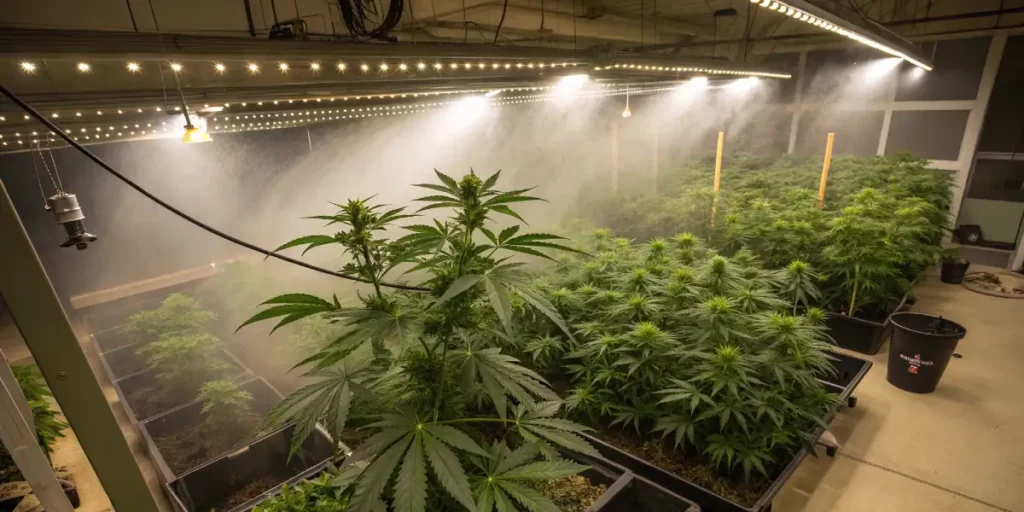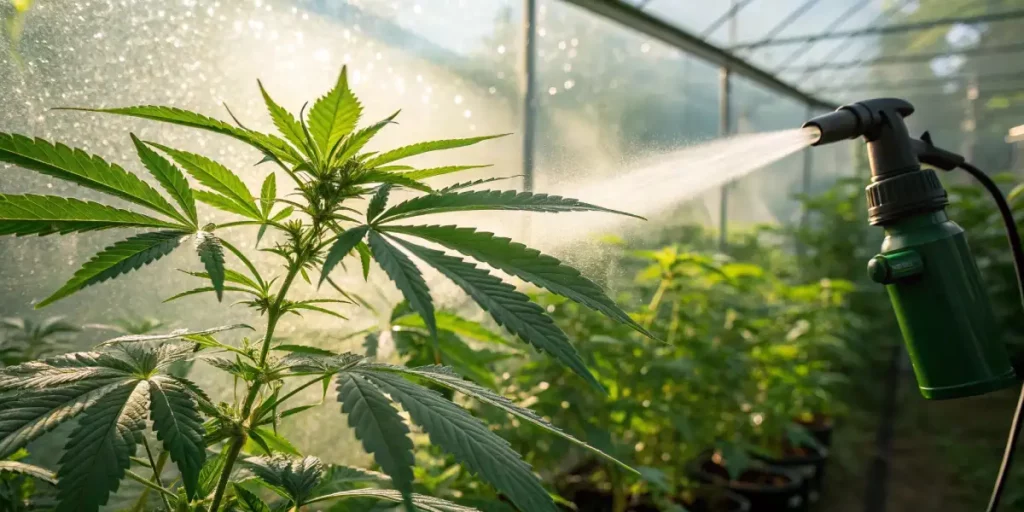Foliar feeding cannabis involves spraying a nutrient solution directly onto the leaves of the cannabis plant. This technique allows plants to absorb nutrients quickly through their leaves, bypassing the roots. It’s a popular method for addressing nutrient deficiencies and boosting plant health.
Many growers appreciate foliar feeding for its ability to provide rapid results. When nutrients are sprayed onto the leaves, they can be absorbed in as little as 15 to 30 minutes. This is particularly useful when plants show signs of deficiencies and need a quick fix.
For both newcomers and seasoned growers, this method offers a way to directly influence plant health. By applying nutrients directly to the leaves, growers can ensure that their plants receive an immediate nutrient boost, which can be especially important during critical growth phases.
Benefits of Foliar Feeding Cannabis
One of the primary benefits of foliar feeding cannabis is its efficiency. When you apply nutrients directly to the leaves, you avoid potential nutrient lockout issues that can occur in the soil. This ensures that your plants get the nutrients they need without delay.
Foliar feeding can also help improve the overall health of the plant. By providing nutrients directly to the leaves, you can address deficiencies more precisely. This can lead to healthier, more robust plants that are better equipped to produce high-quality buds.
Additionally, this method can be a cost-effective way to deliver nutrients, as it often requires smaller amounts of solution compared to soil application. This can be particularly advantageous for large-scale operations or growers on a budget.
Furthermore, foliar feeding allows for targeted nutrient application. Growers can tailor the nutrient solution to address specific deficiencies observed in the leaves, making it a precise and customized approach to plant care.
How to Foliar Feed Cannabis Plants
To foliar feed cannabis plants effectively, you’ll need a spray bottle or a garden sprayer. Mix your nutrient solution according to the instructions, ensuring it’s suitable for foliar application. It’s crucial to use a fine mist setting to cover the leaves evenly without causing drips.
Apply the foliar spray in the early morning or late afternoon. This timing helps prevent leaf burn, which can occur if the solution sits on leaves during the hottest part of the day. Be sure to spray both the top and underside of the leaves for maximum absorption.
It’s essential to regularly clean your spray equipment to prevent any buildup or residue that might affect the foliar feeding process. Consistent maintenance of your tools ensures that your nutrient solutions remain effective and uncontaminated.
When considering how to foliar feed cannabis plants, remember to adjust the nutrient concentration based on your plant’s growth stage. Younger plants may require a more diluted solution, while mature plants can handle slightly higher concentrations.

Foliar Feeding Schedule for Cannabis
Creating a foliar feeding schedule for cannabis is essential for optimal results. A typical schedule might involve foliar feeding once a week, though this can vary depending on the plant’s stage of growth and specific needs.
During the vegetative stage, foliar feeding can be more frequent as plants are actively growing and can benefit from additional nutrients. As you transition to the flowering stage, it’s wise to reduce frequency to avoid affecting bud development.
Adjusting your foliar feeding schedule for cannabis based on environmental conditions is also important. For instance, plants in hot, dry climates might benefit from more frequent applications to compensate for faster evaporation rates.
Furthermore, always observe your plants’ responses to the foliar feeding schedule. If you notice any signs of nutrient excess or deficiency, be prepared to modify the frequency and nutrient composition accordingly.
Best Nutrients for Foliar Feeding Cannabis
Choosing the best nutrients for foliar feeding cannabis is crucial. Look for nutrients specifically formulated for foliar application. These often include micronutrients like calcium, magnesium, and iron, which can be swiftly absorbed through the leaves.
Many growers find success with products that contain seaweed extract, as it promotes overall plant health and resilience. Fish emulsion is another favorite, known for its rich nitrogen content, which is beneficial during the vegetative stage.
It’s also beneficial to explore organic and natural nutrient options, which can be gentler on plants and the environment. Products derived from kelp or other marine sources often provide a wide range of essential nutrients.
When selecting the best nutrients, always consider the specific needs of your plants. Different strains may have varying requirements, so tailoring your nutrient mix can lead to better results.
Real-Life Examples of Successful Foliar Feeding
Consider the experience of a grower using the Granddaddy Purple strain. By incorporating foliar feeding into their routine, they noticed a significant improvement in leaf color and bud size.
Another grower cultivating Blue Dream reported healthier plants and increased resistance to pests. The direct nutrient application helped the plants recover from minor deficiencies quickly.
In one instance, a cultivator using foliar spray recipes for cannabis plants found that their White Widow strain exhibited enhanced trichome production, resulting in more potent buds.
These real-life examples underscore the potential of foliar feeding cannabis to transform plant health and productivity when integrated thoughtfully into a grower’s regimen.

FAQs on Foliar Feeding Cannabis
Is Foliar Feeding Cannabis Safe?
Foliar feeding cannabis is generally safe when done correctly. It’s important to use products specifically formulated for foliar feeding to avoid damaging the plants. Always follow the recommended dilution rates to prevent nutrient burn.
Be mindful of the timing of your applications. Spraying during cooler parts of the day helps prevent leaf burn. Regularly monitor your plants for any adverse reactions and adjust your methods as necessary.
Ensuring proper ventilation in your grow area is another important safety consideration. Adequate airflow allows leaves to dry quickly, minimizing the risk of mold or mildew development.
As with any nutrient application, individual plant responses may vary. It’s advisable to test foliar feeding on a small section of your crop before applying it widely to ensure compatibility and safety.
Can I Foliar Feed During Flowering?
Foliar feeding during the flowering stage is possible but should be approached with caution. Excessive spraying can lead to mold or mildew if the buds retain moisture. It’s best to reduce the frequency of foliar feeding once flowering begins.
Some growers choose to stop foliar feeding entirely during flowering to avoid any potential risks. If you decide to continue, ensure the sprays are very light and avoid getting the solution directly on the buds.
For those who continue foliar feeding during flowering, selecting the right time of day is crucial. Early morning applications when humidity is lower can help reduce the risk of moisture retention.
Additionally, using foliar spray recipes for cannabis plants that are specifically designed for flowering can provide the necessary nutrients without compromising bud quality.
How Often Should I Foliar Feed My Cannabis Plants?
The frequency of foliar feeding cannabis depends on various factors, including the plant’s growth stage and overall health. During the vegetative stage, weekly applications are common. Monitor your plants and adjust based on their response.
In the flowering stage, reduce the frequency to limit the risk of moisture-related issues. Always observe how your plants react and make changes to your schedule as needed.
Foliar feeding schedule for cannabis may also vary based on the specific nutrient solution used. Some solutions are formulated for more frequent applications, while others are designed for periodic use.
Ultimately, the key is to remain adaptable and responsive to your plants’ needs. Consistent observation and adjustments will help you determine the optimal foliar feeding schedule for your cannabis crop.
What Are Some Effective Foliar Spray Recipes for Cannabis Plants?
There are several effective foliar spray recipes for cannabis plants. A simple recipe includes water, a few drops of liquid seaweed, and a small amount of fish emulsion. This combination provides a balanced nutrient boost for healthy growth.
Another popular recipe involves mixing water with a calcium-magnesium supplement. This is particularly effective for preventing deficiencies in these critical nutrients. Always dilute your solutions according to the product instructions.
Experimenting with different foliar spray recipes for cannabis plants allows growers to find the perfect balance of nutrients to suit their specific needs. Customizing nutrient blends can lead to optimal plant health and yield.
It’s advisable to keep detailed records of the recipes used and the results observed. This practice can help refine your approach over time, ensuring consistent success with foliar feeding cannabis.
Are There Any Drawbacks to Foliar Feeding Cannabis?
While foliar feeding cannabis has many benefits, there are potential drawbacks. Over-application can lead to nutrient burn, causing damage to the leaves. It’s also possible for moisture to lead to mold or mildew if conditions are too humid.
To minimize these risks, use foliar feeding as a supplement rather than the sole method of nutrient delivery. Ensure your growing environment has adequate airflow to help leaves dry quickly after application.
Being vigilant about the condition of your plants is crucial. Regularly inspecting leaves for signs of burn or disease can help you catch issues early and adjust your foliar feeding practices accordingly.
Ultimately, with careful planning and execution, the drawbacks of this nutrient delivery method can be mitigated, allowing growers to reap its full benefits.

